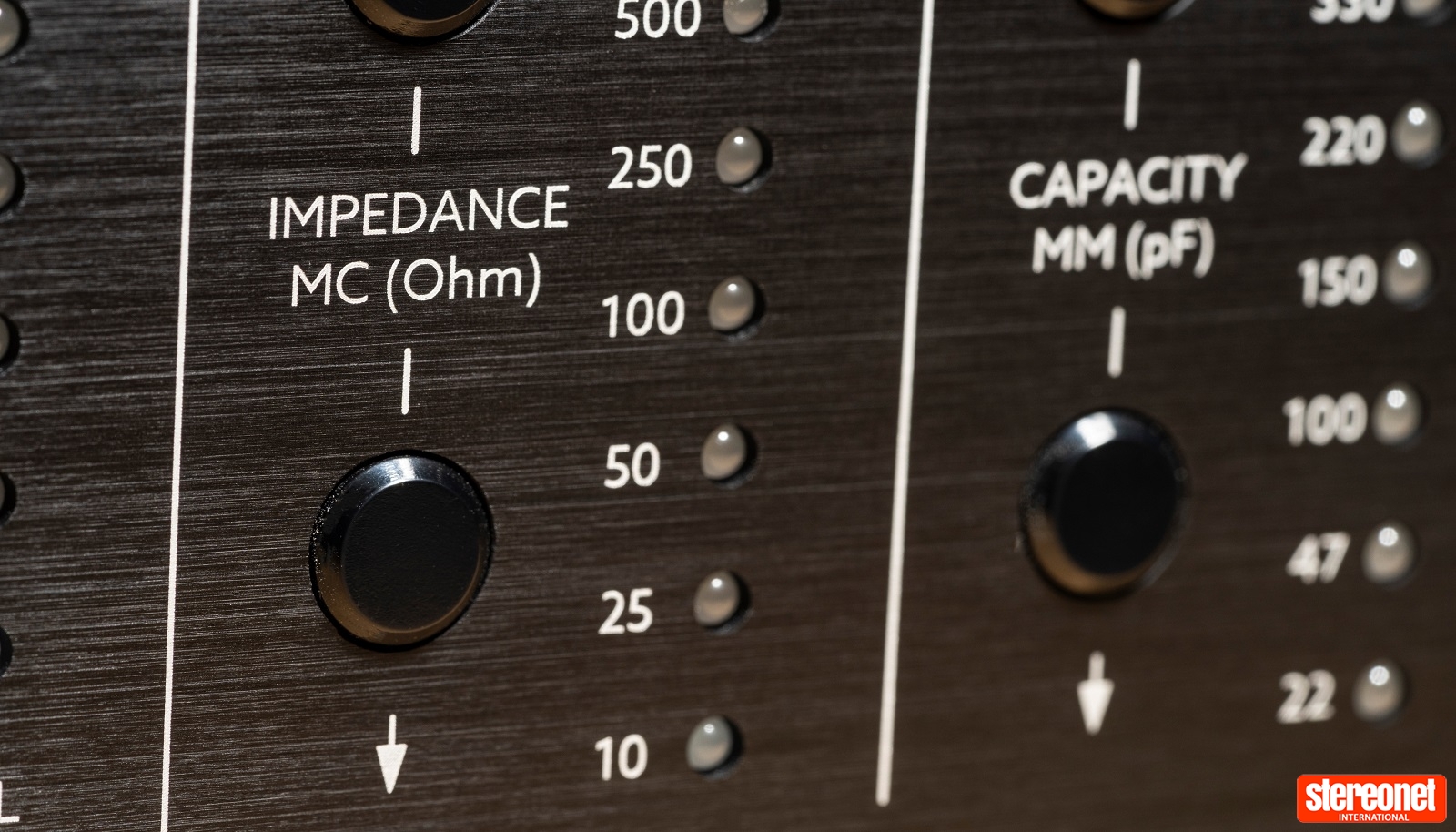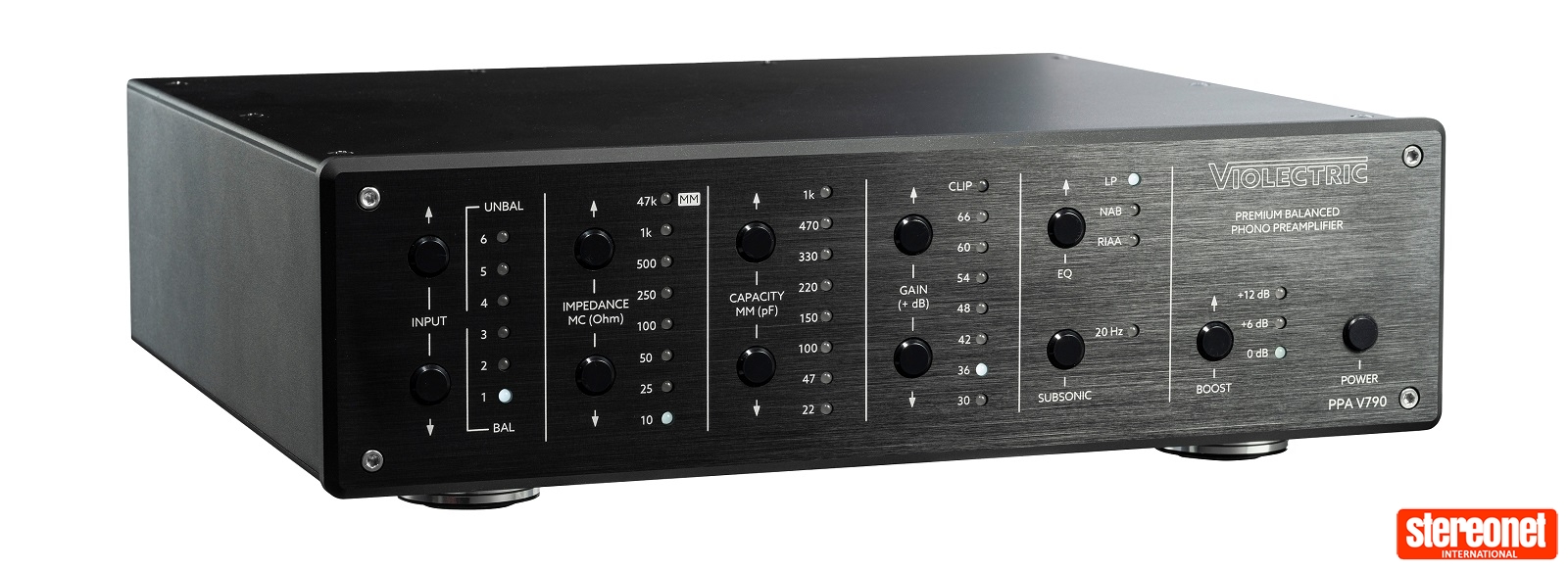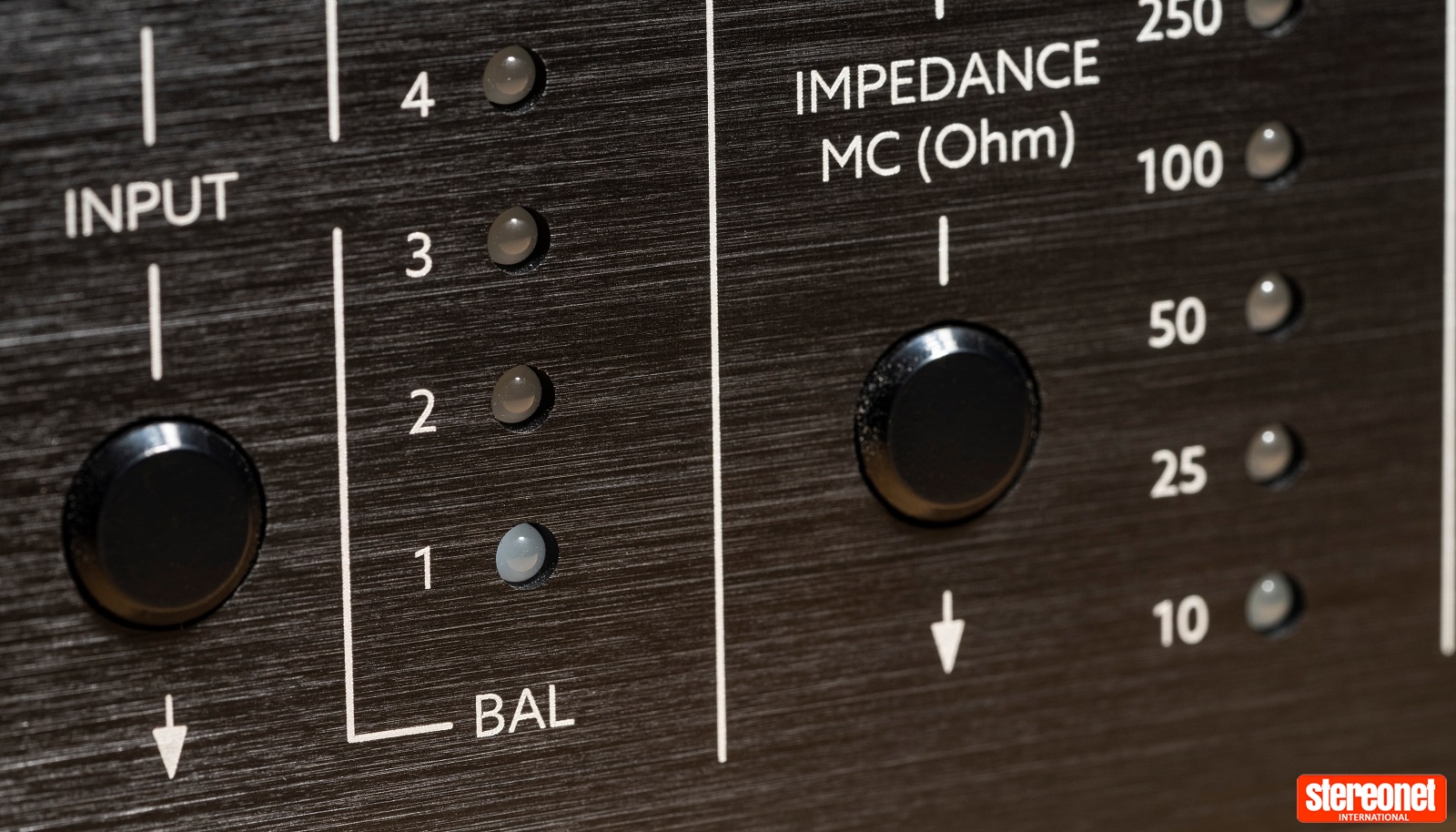Violectric PPA V790 Phono Stage Review

Jimmy Hughes cues up this innovative and flexible high-end phono stage, purpose-built for serious record collectors…
Violectric
PPA V790 Phono Stage
£3,490

For keen vinylistas who own more than one turntable, this phono stage is an enticing proposition. With no fewer than six moving coil and moving magnet inputs – three unbalanced (RCA/Phono) and three balanced (XLR) – it is extensively customisable for gain, impedance, and capacitance. Moreover, as well as the industry-standard RIAA EQ curve, it offers a couple of different equalisation settings. So this state-of-the-art product is an invaluable tool for demonstrating and comparing turntables and cartridges – even more so since each input is individually customisable and the unit remembers all your settings.
While it's not uncommon for phono stages to offer user-adjustable impedance, capacitance, and gain, many do so via small, fiddly dip switches located in awkward places. All adjustments on the Violectric PPA V790 are made via convenient front-panel press-buttons. Each setting is relay-controlled and has its own LED indicator. So, you can see at a glance how things are configured. Indeed, there are no fewer than 37 LEDs on the front panel, but they only remain lit for a few seconds after you change a setting to avoid an excess of lights glaring at you. The case is made from black anodised aluminium and measures 290x90x254mm.

Despite the PPA V790 being pretty compact, the power supply is built-in rather than housed in a separate box. This has been done to achieve optimum grounding with short connection paths. However, a potential downside with built-in power supplies in a small case is hum pickup from the mains transformer. Fortunately, the Violectric is completely hum-free due to careful design and the use of high-grade components. Likewise, hiss levels are extremely low even at maximum gain. The phono stage is also physically silent, as there's no mechanical transformer buzz. Power consumption is around 10W, and the casework gets mildly warm after an hour or so. I kept the unit powered on, but warm-up time seems minimal, and there is very little – if any – change in sound after switch on.

It's not unusual to encounter phono stages with balanced XLR outputs, but those offering balanced inputs are less common. Most cartridges are naturally balanced and only need suitable wiring to operate this way. With balanced operation, the two negative output terminals of the cartridge are kept separate and not grounded. The negative is, therefore, active and thus a mirror image of the positive. Among other benefits is a high rejection of common-mode noise, which is especially important with low-level signals. If your tonearm has a standard plug-in arm cable with RCA phono plugs, this can usually be replaced with a balanced type cable featuring XLRs. Prior to the Violectric's arrival, I'd actually been listening to my turntable balanced using a Chord Symphonic phono stage.
THE LISTENING
My review unit immediately sounded impressive, with a clean, unexaggerated character and innate purity and rightness. The presentation is open and detailed, natural and refined. The various loading and gain options allow you to tailor the tonal balance, but the key qualities outlined remain. You feel you're hearing exactly what's on the disc, with nothing added or taken away. The overall delivery has an effortless transparency and clarity, albeit not in a manner that ever seems overly analytical or clinical. The resulting sound is rewarding and easy to listen to – it's both intellectually informative and emotionally engaging.

The PPA V790 is very adaptable. Input gain ranges from +30dB to +66dB in 6dB steps, and usefully, there's a red LED to indicate overload. When deciding on the correct gain, most users will probably choose a setting that equates to the volume level of other sources, such as a CD player or a streamer. My preference is for a highish gain because this subjectively improves focus, resolution, and immediacy. However, if your taste is for a softer, gentler and slightly less assertive sonic presentation, reducing the gain can deliver this.
In addition to variable input gain, the PPA V790 offers a choice of three output levels – namely 0dB, +6dB, and +12dB – and there are also three equalisation curves. Not many phono stages can boast such a wide range of options. Equalisation is used to ensure a flat frequency response, but the exact degree of treble cut and bass boost varies slightly. RIAA eventually became the accepted industry standard in the late nineteen fifties, but many record labels had their own EQ prior to this. Alas, old records cut with EQ other than RIAA are rarely labelled as such, so it's a bit of a minefield. The NAB and LP Columbia curves are intended for certain LPs from the early fifties; the subjective variation between these and NAB are pretty subtle – NAB just sounds a tad fuller.

The LP Columbia EQ setting makes more of a difference. It's about 2dB or so louder and seems to lift the lower midband area, making things sound noticeably richer and deeper. Incidentally, 'Columbia' refers to Columbia Broadcasting Systems, or CBS – not the EMI/HMV Columbia. Many old mono LPs that sound tonally thin with RIAA EQ will benefit from the LP Columbia EQ or NAB settings. Trying an early fifties Decca LXT pressing of Vaughan Williams' London Symphony, I found the results from NAB and LP Columbia preferable to RIAA EQ.
Playing an American pressing of Stravinsky's Persephone on Columbia (the original fifties LP, not the sixties stereo remake), LP Columbia sounded noticeably richer and more weighty than the thinner-sounding RIAA EQ. The resulting improvement was quite impressive. But best not be too scientific about this. Just compare the EQ options offered and choose whichever sounds best. Given that LPs cut with equalisations other than RIAA are likely to be from the mono era, it's disappointing that Violectric did not equip the PPA V790 with a stereo/mono button.

After using the PPA V790 via its balanced inputs for a week or so, I changed my tonearm cable and tried it unbalanced. Surprisingly, there was no drop in volume. I expected a reduction of about 3dB, but if anything, the unbalanced input might actually have sounded a tiny bit louder. The reproduction unbalanced wasn't quite as effortlessly transparent and spacious as balanced, but still seemed very cohesive. There was a nice, energetic presence that proved crisp and engaging. I feared unbalanced might disappoint after balanced, but that wasn't quite the case.
Nevertheless, there's no question that balanced delivers a distinctly more sophisticated sound, with greater finesse and delicacy, plus a wider range of tonal variation. The unbalanced option was less mellifluous – tonally, a shade harder and drier, and a tad more assertive.

Listening to a 1967 Philips recording of Rodrigo's Concierto Anduluz for four guitars and orchestra, I was impressed by the way the PPA V790 in balanced mode revealed a clear sense of depth and tonal sheen from a recording that can easily sound brash and congested. Playing Claudio Arrau's 1964 recording of Beethoven's first piano concerto (also Philips) with Bernard Haitink conducting the Concertgebouw orchestra, the sound was focused and clean, displaying impressive warmth, clarity, and excellent instrumental separation.
During the first movement, I heard some very deep noises – like heavy footfall – that I'd never previously noticed. Being DC-coupled, the PPA V790 can reproduce very low frequencies. Fortunately, there's an effective rumble filter to reduce frequencies below 20Hz. I've known the Arrau/Haitink Beethoven concertos set for about fifty years. The performances are excellent, but by the seventies, these sixties recordings had begun to sound a tad dated when compared to newer sets from Ashkenazy/Solti (1973) or Brendel/Haitink (1976). Yet, via this phono stage, my old Arrau/Haitink LPs sounded unexpectedly rich and refined, with a nice sense of depth and plenty of immediacy and presence. Everything right with the recordings seemed to be highlighted, with none of the less good aspects intruding.

However, changing from balanced to unbalanced, the sound lost some of its sheen and started to show its age. I was more aware of that grainy gruffness you get with old recordings. Massed strings had a touch of tonal hardness, while instrumental separation was reduced. Going back to balanced, the sound was immediately more refined and natural. There was extra space around the piano, while wind and brass instruments were better defined. It was as if I'd upgraded the cartridge to a significantly better one and/or ultrasonically cleaned the LP. The PPA V790 sounds perfectly good unbalanced, but in the quest for that last 'nth degree of quality, balanced gives you an important head start. It's an innate advantage over rival phono stages limited to unbalanced inputs.

As for me, I quickly became smitten with the PPA V790. It is among the best-sounding and most versatile phono stages that I have ever used. Its wide range of impedance/capacitance adjustments and gain settings make it the master of every situation. Balanced inputs are the icing on the cake. Comparing it to the Chord Symphonic, I found the two very close in terms of tonal balance, clarity, fine detail, and overall presentation. But the Violectric always seemed a fraction cleaner, a shade more effortless and natural sounding. There wasn't a lot in it, but the PPA just edged it.
THE VERDICT
 With a combination of relaxed naturalness, refinement, and separation, plus keen presence and rhythmic drive, Violectric's PPA V790 working via its balanced inputs – and outputs, too, if possible – lets you fully experience what's possible from LP records. It's the real deal and hugely impressive, even when factoring in its premium price.
With a combination of relaxed naturalness, refinement, and separation, plus keen presence and rhythmic drive, Violectric's PPA V790 working via its balanced inputs – and outputs, too, if possible – lets you fully experience what's possible from LP records. It's the real deal and hugely impressive, even when factoring in its premium price.
Visit Violectric for more information
James Michael Hughes
An avid audiophile for many decades, Jimmy has been writing about hi-fi since 1980 in a host of British magazines, from What Hi-Fi to Hi-Fi Choice. Based in London, England, he’s one of the UK’s most prolific record and CD collectors – no streaming service can yet match his amazing music collection!
Posted in: Amplifiers | Phono Preamplifiers | Applause Awards | 2023 | Hi-Fi
JOIN IN THE DISCUSSION
Want to share your opinion or get advice from other enthusiasts? Then head into the Message
Forums where thousands of other enthusiasts are communicating on a daily basis.
CLICK HERE FOR FREE MEMBERSHIP
Trending
applause awards
Each time StereoNET reviews a product, it is considered for an Applause Award. Winning one marks it out as a design of great quality and distinction – a special product in its class, on the grounds of either performance, value for money, or usually both.
Applause Awards are personally issued by StereoNET’s global Editor-in-Chief, David Price – who has over three decades of experience reviewing hi-fi products at the highest level – after consulting with our senior editorial team. They are not automatically given with all reviews, nor can manufacturers purchase them.
The StereoNET editorial team includes some of the world’s most experienced and respected hi-fi journalists with a vast wealth of knowledge. Some have edited popular English language hi-fi magazines, and others have been senior contributors to famous audio journals stretching back to the late 1970s. And we also employ professional IT and home theatre specialists who work at the cutting edge of today’s technology.
We believe that no other online hi-fi and home cinema resource offers such expert knowledge, so when StereoNET gives an Applause Award, it is a trustworthy hallmark of quality. Receiving such an award is the prerequisite to becoming eligible for our annual Product of the Year awards, awarded only to the finest designs in their respective categories. Buyers of hi-fi, home cinema, and headphones can be sure that a StereoNET Applause Award winner is worthy of your most serious attention.





